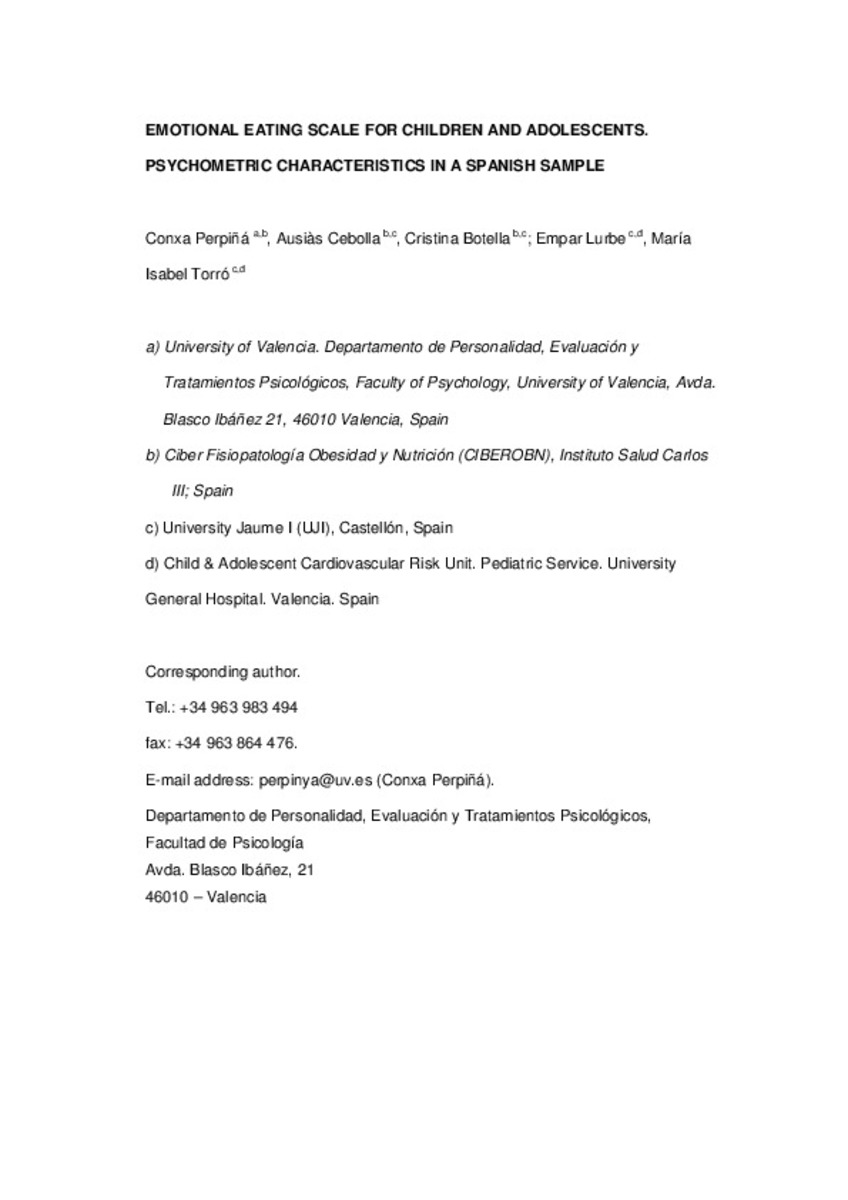Mostrar el registro sencillo del ítem
Emotional eating scale for children and adolescents: psychometric characteristics in a Spanish sample
| dc.contributor.author | Perpiñá Tordera, Concha | |
| dc.contributor.author | Cebolla Marti, Ausias | |
| dc.contributor.author | Botella, Cristina | |
| dc.contributor.author | Lurbe Ferrer, Empar | |
| dc.contributor.author | Torró, María Isabel | |
| dc.date.accessioned | 2012-05-31T10:27:00Z | |
| dc.date.available | 2012-05-31T10:27:00Z | |
| dc.date.issued | 2011 | |
| dc.identifier.citation | Journal of clinical child and adolescent psychology (2011), vol. 40, no. 3, 424-433 | ca_CA |
| dc.identifier.citation | Conxa Perpiñá, Ausiàs Cebolla, Cristina Botella, Empar Lurbe & María-Isabel Torró (2011): Emotional Eating Scale for Children and Adolescents: Psychometric Characteristics in a Spanish Sample, Journal of Clinical Child & Adolescent Psychology, 40:3, 424-433 | |
| dc.identifier.issn | 1537-4416 | |
| dc.identifier.issn | 1537-4424 | |
| dc.identifier.uri | http://hdl.handle.net/10234/39460 | |
| dc.description.abstract | The aims of this study were to validate the Emotional Eating Scale version for children (EES-C) in a Spanish population and study the differences in emotional eating among children with binge eating (BE), overeating (OE), and no episodes of disordered eating (NED). The questionnaire was completed by 199 children aged 9 to 16 years. Confirmatory factor analysis revealed five scales: eating in response to anger, anxiety, restlessness, helplessness, and depression. The EES-C showed good internal consistency and test–retest reliability, and it showed moderate relationships with measures of disordered-eating [Children's Eating Attitudes Test-26 (ChEAT-26), Questionnaire of Eating and Weight Patterns–Adolescent Version (QEWP-A)] and psychopathology (State-Trait Anxiety Inventory for Children, Children's Depression Inventory, Child Behavior Checklist). There were significant differences between the BE/NED groups (with the OE group in the middle position) in desire to eat when Anger (the girls in BE group, and the oldest children in OE group obtaining higher scores) or Helplessness were present. Eating due to Depression was higher in the older groups. Multiple regression analysis conducted showed that anxiety-trait was the best predictor of emotional eating. Results support the potential utility of the EES-C in the study of emotional eating in children and its validity in the Spanish population | ca_CA |
| dc.format.extent | 31 p. | ca_CA |
| dc.format.mimetype | application/pdf | ca_CA |
| dc.language.iso | eng | ca_CA |
| dc.publisher | Taylor & Francis | ca_CA |
| dc.relation.isFormatOf | Versió pre-print del document publicat a: http://www.tandfonline.com/doi/pdf/10.1080/15374416.2011.563468 | ca_CA |
| dc.rights | © 2011 Taylor & Francis | ca_CA |
| dc.rights.uri | http://rightsstatements.org/vocab/InC/1.0/ | * |
| dc.subject | Emotional eating | ca_CA |
| dc.subject | Binge eating disorder | ca_CA |
| dc.subject | Children psychopathology | ca_CA |
| dc.subject | Loss of control | ca_CA |
| dc.subject | Psychometric properties | ca_CA |
| dc.subject.other | Infants--Alimentació--Aspectes psicològics | ca_CA |
| dc.subject.other | Children--Nutrition--Psychological aspects | ca_CA |
| dc.title | Emotional eating scale for children and adolescents: psychometric characteristics in a Spanish sample | ca_CA |
| dc.type | info:eu-repo/semantics/article | ca_CA |
| dc.identifier.doi | http://dx.doi.org/10.1080/15374416.2011.563468 | |
| dc.rights.accessRights | info:eu-repo/semantics/openAccess | ca_CA |
| dc.type.version | info:eu-repo/semantics/submittedVersion | ca_CA |
Ficheros en el ítem
Este ítem aparece en la(s) siguiente(s) colección(ones)
-
PSB_Articles [1303]
Articles de publicacions periòdiques







